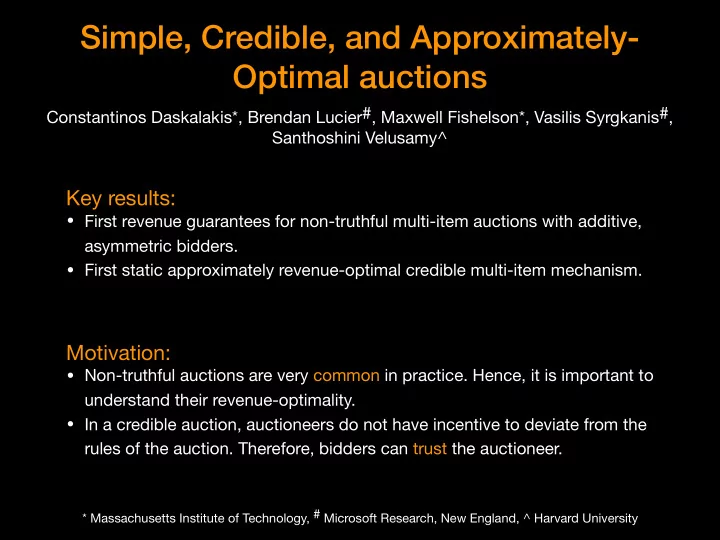

Simple, Credible, and Approximately- Optimal auctions Constantinos Daskalakis*, Brendan Lucier#, Maxwell Fishelson*, Vasilis Syrgkanis#, Santhoshini Velusamy^ Key results: • First revenue guarantees for non-truthful multi-item auctions with additive, asymmetric bidders. • First static approximately revenue-optimal credible multi-item mechanism. Motivation: • Non-truthful auctions are very common in practice. Hence, it is important to understand their revenue-optimality. • In a credible auction, auctioneers do not have incentive to deviate from the rules of the auction. Therefore, bidders can trust the auctioneer. * Massachusetts Institute of Technology, # Microsoft Research, New England, ^ Harvard University
General Framework Main theorem: Multi-item auction E(A): If every bidder in A auction does not The auctioneer overbid and pays at most bid, then, • posts bidders-specific entry fees Separate First-price auctions with upfront, monopoly reserves • runs simultaneous single-item A or auctions on all items, • allocates items to those bidders E(A) who paid entry fees. is approximately revenue-optimal. Non-truthful auction: E(First-Price), E(All-Pay) Credible auction: E(All-Pay)
Proof of main theorem: E(First-Price) [CDW16] Decomposition of type- space into “upward-closed” Core problem: regions: Need to upper bound welfare-loss of ( t 1 , t 2 , t 3 , t 4 ) → ( t 1 , t 2 , ϕ ( t 3 ), t 4 ) first-price auctions. Worst-case scenarios: • Welfare-loss is a constant fraction of optimal welfare. • Optimal welfare is arbitrarily larger than optimal revenue. Main idea: Both worst cases cannot Optimal revenue ≤ Virtual welfare co-exist! Goal: Upper bound virtual welfare. [CDW16] - Yang Cai, Nikhil R. Devanur, and S. Matthew Weinberg. A duality-based unified approach to bayesian mechanism design, STOC 2016.
Box-Lemma max b − i 𝖲𝖿𝗐 ( 𝖰𝖰 ) + u i ( t i ) ≥ t i 1 CDF 1 Utility u i ( t i ) 0 bid b i t i 0 bid PP - Posted Price 1 max{ t i } i ∈ [ n ] 1 CDF Rev(PP) 0 bid 0 t i Welfare loss of first-price auctions ≤ 4 • Rev(PP) lies above max b − i max{ t i } i ∈ [ n ]
Recommend
More recommend